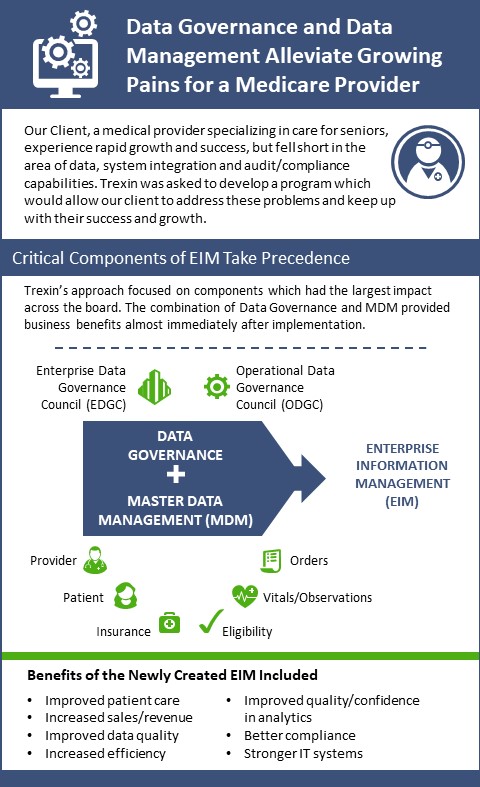Managing Data For A National Medicare Provider
Trexin established an Enterprise Information Management practice for a rapidly growing, national Medicare provider.

Business Driver
Specializing in primary care for seniors, our Client experienced explosive success, growing in five years from 5,000 patients to over 30,000 patients served by 37 medical centers in 25 cities within 8 markets. This rapid growth led to serious data quality issues, heavy manual intervention for most key processes, and business-level distrust of applications and data. A lack of adoption of industry standard data conventions also led to challenges integrating systems with 3rd parties, and internal audit and regulatory compliance capabilities were strained. To address these problems, the company’s CTO asked Trexin to lead an effort to establish an Enterprise Information Management (EIM) practice.
Approach
EIM has several key components, but Trexin recommended that our Client first focus on Data Governance and Master Data Management (MDM), which are the most critical components and the ones on which the others rely. Working quickly, Trexin introduced a comprehensive Data Governance model that included the creation of an Enterprise Data Governance Council (EDGC), comprising business leaders that represent corporate functions across the enterprise to provide “light-touch, high impact” authority, and an Operational Data Governance Council (ODGC) that was business-led and IT-supported with responsibility for data stewardship and data lifecycle management.
After addressing Data Governance, Trexin then shifted to MDM, focusing on mastering several data domains, including Provider, Patient, Insurance, Eligibility, Vitals/Observations, and Orders. Our approach emphasized single-authority definition, management, and control for each data element. To address data access needs, industry-standard HL7 Fast Healthcare Interoperability Resources (FHIR) data objects and services were developed and deployed.
Results
Almost immediately, the combination of Data Governance and MDM began to provide numerous business benefits. For example, patient care improved by detecting duplicate and unnecessary orders as a result of mastering the Patient and Order domains. Sales/revenue increased by providing higher quality data that led to recognition of missed billing opportunities. Improved data quality and validation allowed the company to close HEDIS gaps and improve their score. Additional benefits included increased efficiency (e.g., fewer front-desk manual interventions to assign patients to appropriate insurance plan-benefit packages driven by automated MDM matching technology); improved quality and confidence in analytics/reporting; better compliance (e.g., lockdown of Patient and Insurance history records); and stronger, more scalable IT systems.



